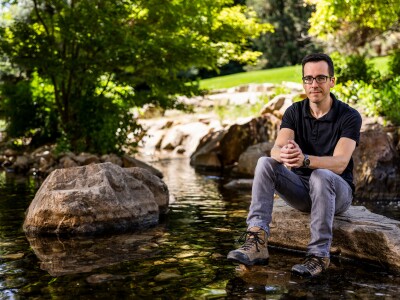New BYU and Brown study of 2000 elections relevant to 2004 voting, researcher says
With a comment that reflects the conventional wisdom still held today, then-Vice President Al Gore told reporters at a Nov. 28 press conference during the disputed 2000 presidential election process, "One thing to remember is that the old and cheap, outdated machinery is usually found in areas with populations that are of lower income, minorities, seniors on fixed incomes."
A new study of the voting machines used in the election contradicts that notion, commonly held not just by Gore but by many officials and pundits today, which is being repeated in advance of the 2004 contest. Older voting equipment, like punchcard machines, was more likely to be found in counties richer than the national average, according to an article by professors at Brigham Young University and Brown University forthcoming in the journal "Public Choice." In another surprising finding, the study found punchcard machines were more likely to be used in counties with lower percentages of minorities and seniors.
"The conventional wisdom, at least on the national average, is that these old machines were concentrated in poor areas with many seniors on fixed incomes and many minorities," said Phillip Garner, Brigham Young University assistant professor of economics. "It turns out to be the opposite."
A separate analysis by Election Data Services has noted that 74 percent of voters in the upcoming presidential campaign will use the same voting equipment they used in 2000. Twelve percent of registered voters will use punchcard machines, like those that spurred controversy in Florida, in 22 states.
Comments like Gore's influenced Garner and his co-author, Brown University's Enrico Spolaore, to investigate what factors influence counties' choice of voting machines. Their initial inquiry resulted in a surprise.
Even at first glance, they saw the median income of the people in counties using punchcard machines was higher than the median income of people in counties using other voting equipment, including new technologies like electronic machines or optical scanners. The percentage of minorities in counties using punchcards was 12.5, lower than the percentage of minorities in counties using the newer equipment.
To ensure that the summary percentages were painting an accurate picture, Garner and Spolaore subjected the data to a statistical technique called regression analysis. They used information on the types of voting machines from all 3141 counties in the United States, and demographic data such as income, race and age from the U.S. census.
"The formal analysis looked at income's effect on the type of voting machine, controlling for other demographic factors like population and racial and age composition," Garner said. "Even when we controlled for these other factors, we still found that having a higher income increased your chance of using this older technology."
Having established the pattern, Garner and Spolaore sought to find its cause. Why would richer counties have older voting machines? The answer rested not in present trends, but past ones. Looking back, the researchers discovered that richer counties had upgraded their voting technology about 30 or 40 years ago, while poorer counties held on to their old-fashioned paper ballots until more recently, when their upgrades led to adoption of newer equipment like optical scanners or electronic machines. The result was poorer counties leapfrogging richer ones.
"The current distribution of voting machines is a result of a decades-long historical process," Garner explains. "The richer counties today also tended to be richer counties in the past, so when they adopted the state-of-the-art technology back in the 1960s – punchcard machines that mechanized their system -- they didn't have a lot of incentive to upgrade to the next newest type of technology."
The phenomenon is similar to the trend of developing countries adopting cell phones without ever having installed telephone lines, Garner said, while richer countries still have a national network of phone lines that are slowly giving way to cell phones.
Although the study looked at the 2000 election, Garner believes its general conclusions apply to the upcoming balloting. "Twelve percent of the country will still be using punchcard machines and 14 percent will be using lever machines, and we learned that these are not necessarily poorer people," he said.
Another implication of the study applies to the possibility of upgrading the nation's voting infrastructure. The choice of voting equipment in the United States is decentralized, left up to the states and in many cases to individual counties.
"If the federal government acted using federal tax dollars to update the older machinery," Garner said, "since the older machinery is in on-average wealthier counties, in a sense it would be the poorer counties subsidizing the richer counties. There might be an equity issue involved in this."






